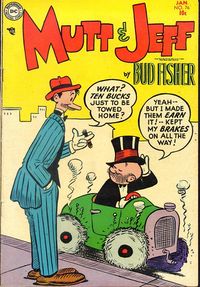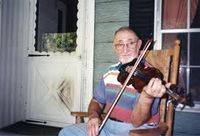Annotation:Mutt and Jeff: Difference between revisions
No edit summary |
m (Text replacement - "garamond, serif" to "sans-serif") |
||
| Line 1: | Line 1: | ||
=='''Back to [[{{BASEPAGENAME}}]]'''== | =='''Back to [[{{BASEPAGENAME}}]]'''== | ||
---- | ---- | ||
<p><font face=" | <p><font face="sans-serif" size="4"> | ||
'''MUTT AND JEFF.''' Old-Time, Breakdown. D Major ('A' part) & A Major ('B' part). Standard tuning (fiddle). AABB. Mutt and Jeff was a cartoon from the early days of film, dating to 1916, and the longest running theatrical animated short series of the silent era, lasting until 1926. It featured two miss-matched characters, one tall and lanky and the other shorter and spunky, from which the phrase "mutt and jeff" was coined to denote miss-matched pairs. | '''MUTT AND JEFF.''' Old-Time, Breakdown. D Major ('A' part) & A Major ('B' part). Standard tuning (fiddle). AABB. Mutt and Jeff was a cartoon from the early days of film, dating to 1916, and the longest running theatrical animated short series of the silent era, lasting until 1926. It featured two miss-matched characters, one tall and lanky and the other shorter and spunky, from which the phrase "mutt and jeff" was coined to denote miss-matched pairs. | ||
[[File:muttjeff.jpg|200px|thumb|left|]] The title was perhaps inspired by the fact that each strain of the tune is in a different key. While this combination is fairly common in many traditions, particularly for quadrilles, it is not common in the Appalachian South. | [[File:muttjeff.jpg|200px|thumb|left|]] The title was perhaps inspired by the fact that each strain of the tune is in a different key. While this combination is fairly common in many traditions, particularly for quadrilles, it is not common in the Appalachian South. | ||
| Line 7: | Line 7: | ||
<br> | <br> | ||
</font></p> | </font></p> | ||
<p><font face=" | <p><font face="sans-serif" size="4"> | ||
[[File:chapman.jpg|200px|thumb|right|Owen Chapman]] | [[File:chapman.jpg|200px|thumb|right|Owen Chapman]] | ||
''Source for notated version'': Owen 'Snake' Chapman (1919-2003, Canada, Pike County, Ky.) [Phillips]. | ''Source for notated version'': Owen 'Snake' Chapman (1919-2003, Canada, Pike County, Ky.) [Phillips]. | ||
| Line 13: | Line 13: | ||
<br> | <br> | ||
</font></p> | </font></p> | ||
<p><font face=" | <p><font face="sans-serif" size="4"> | ||
''Printed sources'': Phillips ('''Traditional American Fiddle Tunes, vol. 1'''), 1994; p. 160. | ''Printed sources'': Phillips ('''Traditional American Fiddle Tunes, vol. 1'''), 1994; p. 160. | ||
<br> | <br> | ||
<br> | <br> | ||
</font></p> | </font></p> | ||
<p><font face=" | <p><font face="sans-serif" size="4"> | ||
''Recorded sources'': <font color=teal>June Appal JA0061, Owen "Snake Chapman - "Fiddle Ditty." </font> | ''Recorded sources'': <font color=teal>June Appal JA0061, Owen "Snake Chapman - "Fiddle Ditty." </font> | ||
</font></p> | </font></p> | ||
Latest revision as of 14:27, 6 May 2019
Back to Mutt and Jeff
MUTT AND JEFF. Old-Time, Breakdown. D Major ('A' part) & A Major ('B' part). Standard tuning (fiddle). AABB. Mutt and Jeff was a cartoon from the early days of film, dating to 1916, and the longest running theatrical animated short series of the silent era, lasting until 1926. It featured two miss-matched characters, one tall and lanky and the other shorter and spunky, from which the phrase "mutt and jeff" was coined to denote miss-matched pairs.

The title was perhaps inspired by the fact that each strain of the tune is in a different key. While this combination is fairly common in many traditions, particularly for quadrilles, it is not common in the Appalachian South.

Source for notated version: Owen 'Snake' Chapman (1919-2003, Canada, Pike County, Ky.) [Phillips].
Printed sources: Phillips (Traditional American Fiddle Tunes, vol. 1), 1994; p. 160.
Recorded sources: June Appal JA0061, Owen "Snake Chapman - "Fiddle Ditty."
